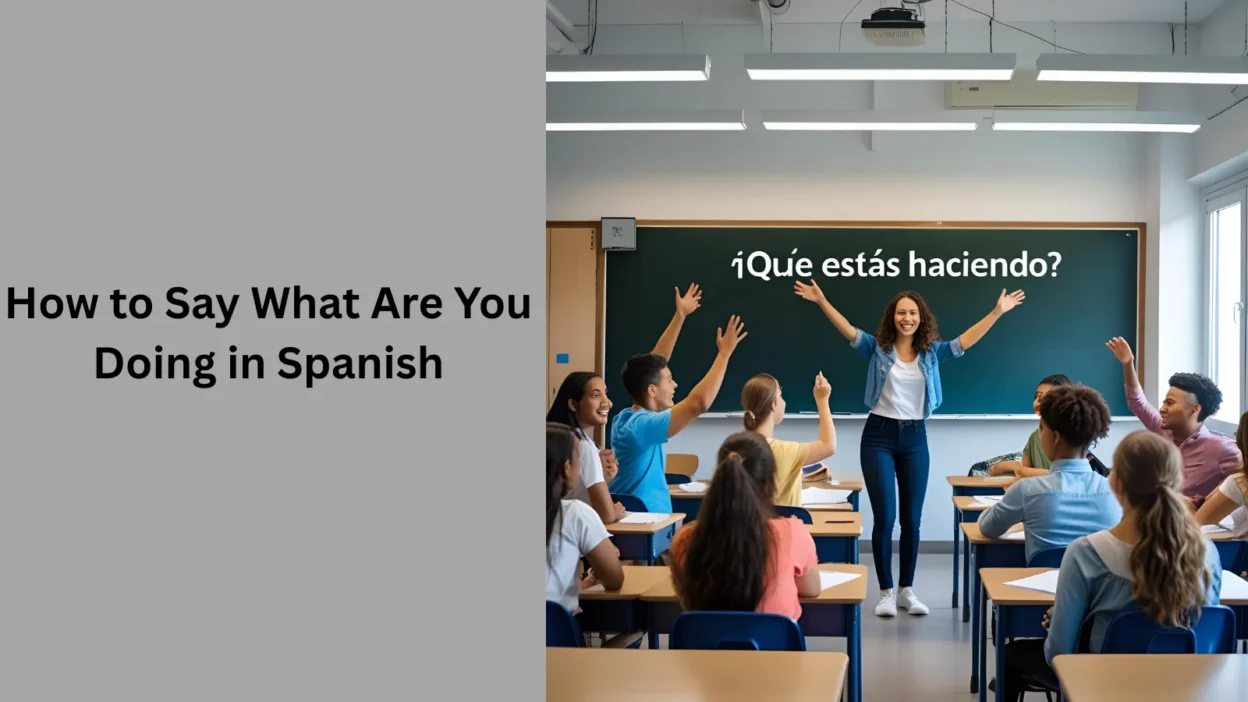Imagine you’re chatting with a new friend from Spain or Latin America, and you want to connect on a deeper level. Asking how to say what are you doing in Spanish can spark a fun, meaningful conversation!
Whether you’re learning Spanish for travel, work, or love, knowing how to ask this simple question opens doors to understanding culture and building relationships. In Spanish, the phrase “What are you doing?” is translated as ¿Qué estás haciendo?
This guide will teach you how to use it naturally, avoid common mistakes, and adapt it for different situations. From casual chats to polite inquiries, we’ll cover everything you need to sound confident and friendly. Let’s dive in and make your Spanish conversations shine!
Why Asking “What Are You Doing?” Matters in Spanish
Asking ¿Qué estás haciendo? is more than just a question—it’s a way to show interest in someone’s life. In Spanish-speaking cultures, personal connections are valued, and this phrase helps you engage with others. Use it to check in with friends, coworkers, or even strangers in a casual setting.
For example, imagine you’re at a café in Mexico, and you see someone sketching. You could say, “¿Qué estás haciendo? ¡Eso se ve increíble!” (What are you doing? That looks amazing!). This opens a friendly chat. However, avoid using it in formal settings, like with a boss, where it might sound too casual. Instead, try “¿En qué está trabajando?” (What are you working on?) for a professional tone.
Do say: “¿Qué estás haciendo? Parece divertido.” (What are you doing? It looks fun.)
Don’t say: “¿Qué haces?” in a rushed way, as it can sound abrupt.
How to Pronounce ¿Qué Estás Haciendo?
Pronunciation is key to sounding natural. The phrase ¿Qué estás haciendo? is pronounced as “keh es-TAHS ah-see-EN-doh”. Break it down: qué (what) sounds like “kay,” estás (are you) is “es-TAHS,” and haciendo (doing) is “ah-see-EN-doh.” Practice slowly, stressing the capitalized syllables.
Picture yourself at a park in Argentina, asking a friend who’s juggling, “¿Qué estás haciendo?” If you mispronounce it, like saying “es-TAYS” instead of “es-TAHS,” it might confuse the listener. Try recording yourself or using apps like Duolingo to perfect it. In a real-life scenario, smile and keep it light—if you stumble, say, “¡Perdón, estoy aprendiendo!” (Sorry, I’m learning!).
Do say: “¿Qué estás haciendo?” with a friendly tone.
Don’t say: “¿Kwe estas asiendo?” as it sounds unnatural and may cause giggles.
When to Use ¿Qué Estás Haciendo? in Conversations
Timing matters when using ¿Qué estás haciendo? This phrase works best in informal settings, like with friends, family, or peers. It’s perfect for catching up or starting a chat. For instance, if you’re video-calling a friend in Colombia who’s cooking, you might say, “¿Qué estás haciendo? ¡Huele rico desde aquí!” (What are you doing? It smells good from here!).
Avoid using it in serious or professional moments. If someone’s visibly busy, like a coworker during a meeting, it could seem intrusive. Instead, try “¿Qué estás trabajando en este momento?” (What are you working on right now?) to sound respectful.
Do say: “¿Qué estás haciendo? Cuéntame todo.” (What are you doing? Tell me everything.)
Don’t say: “¿Qué estás haciendo?” to someone clearly stressed or busy.
Variations of ¿Qué Estás Haciendo? for Different Contexts
Spanish is rich with ways to ask what are you doing? Depending on the region or vibe, you can tweak the phrase. In Spain, you might hear “¿Qué estás haciendo ahora?” (What are you doing now?) for emphasis. In Mexico, “¿Qué andas haciendo?” adds a laid-back feel, like saying “What’s up?” in English.
Imagine you’re texting a friend in Chile. You could say, “¿Qué andas haciendo hoy?” (What are you up to today?) to sound chill. For a more curious tone, try “¿En qué estás ocupado?” (What are you busy with?). Avoid overly formal phrases like “¿Cuál es tu actividad actual?”—it’s clunky and rarely used.
Do say: “¿Qué andas haciendo? Suena divertido.” (What are you up to? Sounds fun.)
Don’t say: “¿Qué actividad realizas?”—it’s too stiff for casual chats.
Common Mistakes to Avoid When Asking in Spanish
Learning how to say what are you doing in Spanish comes with pitfalls. A big mistake is using “¿Qué haces?” instead of “¿Qué estás haciendo?” While both mean “What are you doing?,” “¿Qué haces?” can imply a general habit (like “What do you do for a living?”) and confuse the conversation.
For example, if you’re at a party in Peru and ask “¿Qué haces?” to someone dancing, they might think you’re asking about their job! Stick with “¿Qué estás haciendo?” for actions in the moment. Also, avoid literal translations like “¿Qué eres haciendo?”—it’s grammatically wrong and sounds odd.
Do say: “¿Qué estás haciendo? ¡Qué cool!” (What are you doing? So cool!)
Don’t say: “¿Qué eres haciendo?”—it’s incorrect and confusing.
Practice Scenarios to Master ¿Qué Estás Haciendo?
Practice makes perfect! Here are two scenarios to try ¿Qué estás haciendo?:
- At a market in Guatemala: You see someone painting a mural. Approach with, “¡Hola! ¿Qué estás haciendo? Es hermoso.” (Hi! What are you doing? It’s beautiful.) This invites them to share their art.
- Texting a friend in Puerto Rico: If they send a beach pic, reply, “¡Wow! ¿Qué estás haciendo ahí?” (Wow! What are you doing there?) It’s a fun way to keep the chat going.
Practice with a language partner or tutor to build confidence. If you’re shy, start by texting the phrase to avoid pronunciation pressure.
Do say: “¿Qué estás haciendo? Quiero aprender.” (What are you doing? I want to learn.)
Don’t say: “¿Qué estás haciendo?” in a monotone—it kills the vibe.
Final Thoughts
Mastering how to say what are you doing in Spanish is a game-changer for connecting with Spanish speakers. The phrase ¿Qué estás haciendo? is your ticket to fun, engaging conversations, whether you’re chatting with friends, exploring new cultures, or practicing your skills.
From pronunciation to context, this guide has you covered with practical tips and real-life examples. Avoid common mistakes, try variations like “¿Qué andas haciendo?” for a local flair, and practice in everyday scenarios. With a little effort, you’ll sound natural and confident.
So, go out there, ask ¿Qué estás haciendo?, and watch your Spanish conversations come to life!




